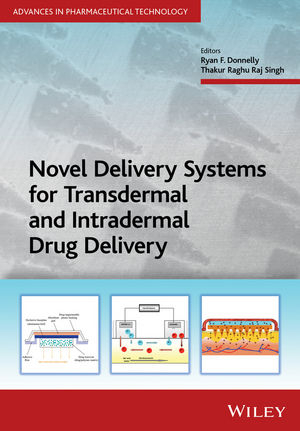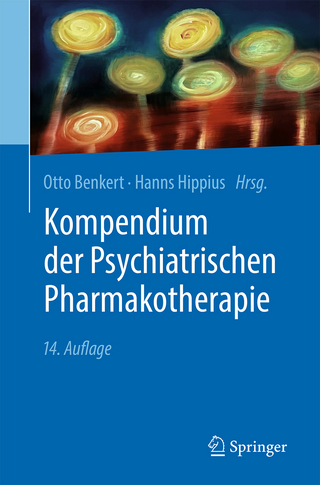
Novel Delivery Systems for Transdermal and Intradermal Drug Delivery
John Wiley & Sons Inc (Verlag)
978-1-118-73451-3 (ISBN)
- Titel z.Zt. nicht lieferbar
- Versandkostenfrei innerhalb Deutschlands
- Auch auf Rechnung
- Verfügbarkeit in der Filiale vor Ort prüfen
- Artikel merken
Dr Ryan Donnelly is Reader in Pharmaceutics at Queen's University Belfast. Dr Donnelly's research is centred on design and physicochemical characterisation of advanced polymeric drug delivery systems for transdermal and topical drug delivery, with a strong emphasis on improving therapeutic outcomes for patients. He is also a technical director at Swedish Pharma AB. Still at a relatively early stage of his career, he has authored over 300 peer-reviewed publications, including 3 patent applications, 3 textbooks, 16 book chapters and approximately 100 full papers. He’s the holder of many awards including the current GSK Emerging Scientist Award. Dr Raj Thakur is Lecturer in Pharmaceutics at Queen's University Belfast. He obtained his PhD in polymer science in 2009 from Queens University Belfast and his MSc in drug delivery in 2006 from University Science Malaysia. He has a BSc in Pharmacy from Jawaharlal Nehru Technological University, India. Dr Thakur's research interests are in development and evaluation of novel in situ forming controlled release implants and ocular and transdermal drug delivery using novel minimally-invasive devices. He has published a textbook and over 30 scientific papers.
About the Editors xiii
Contributors xv
Advances in Pharmaceutical Technology: Series Preface xvii
Preface xix
1 Introduction 1
Gary P.J. Moss
1.1 The Subcutis (Subcutaneous Fat Layer) 1
1.2 The Dermis 2
1.3 Skin Appendages 2
1.4 The Subcutaneous Sensory Mechanism 3
1.5 The Epidermis 5
1.6 The stratum germinativum 5
1.7 The stratum spinosum 5
1.8 The stratum granulosum 6
1.9 The stratum lucidum 6
1.10 The stratum corneum 6
1.10.1 Routes of Absorption 9
1.10.2 Transdermal Permeation – Mechanisms of Absorption 9
1.11 Theoretical Considerations 11
1.12 Physicochemical Properties of the Penetrant 13
1.12.1 Partition Coefficient 13
1.12.2 Molecular Size and Shape 14
1.12.3 Applied Concentration/Dose 15
1.12.4 Solubility and Melting Point 15
1.12.5 Ionisation 15
1.12.6 Physiological Factors Affecting Percutaneous Absorption 16
1.13 Physiological Properties of the Skin 16
1.13.1 Skin Condition 16
1.13.2 Skin Hydration and Occlusion 17
1.13.3 Skin Age 17
1.13.4 Regional Variation (Body Site) 18
1.13.5 Race 19
1.13.6 Skin Temperature 19
1.14 Vehicle Effects 19
1.15 Modulation and Enhancement of Topical and Transdermal Drug Delivery 20
1.15.1 Chemical Modulation of Permeation 21
1.15.2 Physical Methods of Enhancement 26
2 Application of Spectroscopic Techniques to Interrogate Skin 41
Jonathan Hadgraft, Rita Mateus and Majella E. Lane
2.1 Introduction 41
2.2 Vibrational Spectroscopic Methods 42
2.3 Electronic Spectroscopic Methods 46
2.3.1 UV and Fluorescence 46
2.3.2 Nuclear Magnetic Resonance 47
2.4 Miscellaneous Spectroscopic Methods 48
2.4.1 Opto]Thermal Transient Emission Radiometry 48
2.4.2 Electron Spin Resonance 48
2.4.3 Impedance Spectroscopy 49
2.4.4 Laser]Induced Breakdown Spectroscopy 49
2.4.5 Photoacoustic Spectroscopy 50
2.4.6 Mass Spectrometry Imaging 50
2.5 Conclusions and Future 50
3 Analysis of the Native Structure of the Skin Barrier by Cryo]TEM Combined with EM]Simulation 57
Lars Norlén
3.1 Introduction 57
3.2 Our Approach: In Situ Biomolecular Structure Determination in Near]Native Skin 58
3.2.1 Step 1: Cryo]Electron Microscopy of Vitreous Sections 60
3.2.2 Steps 2–3: Molecular Model Building and Electron Microscopy Simulation 66
3.2.3 Step 4: Confrontation of Observed Data with Simulated Data 66
3.3 Molecular Organisation of the Horny Layer’s Fat Matrix 67
3.4 Molecular Organisation of the Horny Layer’s Keratin Filament Matrix 67
3.5 Final Remark 68
4 Intradermal Vaccination 71
Marija Zaric and Adrien Kissenpfennig
4.1 Vaccination 71
4.1.1 Disadvantages Associated with Conventional Vaccination 72
4.2 Dendritic Cells Immunobiology 73
4.3 Skin Anatomy and Physiology 74
4.3.1 The Role of Skin in Vaccine Delivery 75
4.4 The Skin Dendritic Cell Network 76
4.4.1 Langerhans Cells and the ‘Langerhans Cell Paradigm’ 76
4.4.2 Dermal Dendritic Cell Network 77
4.4.3 Dendritic Cell Subsets in the Skin]Draining Lymph Node 79
4.4.4 Human Dendritic Cells in the Skin 80
4.4.5 The Role of Skin Dendritic Cells Subsets in Transdermal Immunisation 81
4.5 The DTR]DT Depletion System 82
4.5.1 Langerin]DTR Mouse Models 83
4.6 Dendritic Cells and the Differentiation of T Lymphocytes 84
4.6.1 CD8+ T Cell Activation 85
4.6.2 CD4+ T Cell Polarisation 85
4.7 Summary 88
5 Film]Forming and Heated Systems 97
William J. McAuley and Francesco Caserta
5.1 Film]Forming Systems 97
5.1.1 The Design of Film]Forming Systems 98
5.1.2 Advantages of Using Film]Forming Systems for Drug Delivery 99
5.1.3 Production of a Supersaturated State 101
5.1.4 Use with Chemical Penetration Enhancers 103
5.1.5 Advantages of Film]Forming Systems for Patient Use 105
5.1.6 Therapeutic Applications 105
5.2 Heated Systems 107
5.2.1 Mechanisms of Drug Penetration Enhancement 107
5.2.2 Partitioning 108
5.2.3 Effects of Heat on Skin 110
5.2.4 Dermal Clearance 111
5.2.5 The Effects of Heat on the Permeation of Drugs Across Skin 112
5.2.6 Strategies for Generating Heat 113
5.2.7 Therapeutic Applications 115
5.3 Conclusions 116
6 Nanotechnology]Based Applications for Transdermal Delivery of Therapeutics 125
Venkata K. Yellepeddi
6.1 Introduction 125
6.1.1 Skin Structure 126
6.1.2 Skin Sites for Nanoparticle Delivery 127
6.1.3 Skin as a Barrier for Nanoparticle Penetration 128
6.1.4 Physicochemical Characteristics of NPs for Penetration through Skin 129
6.2 Nanocarriers for Topical and Transdermal Delivery 129
6.2.1 Polymeric Nanoparticles 130
6.2.2 Lipid Based Nanocarriers 134
6.2.3 Metallic and Mineral Nanoparticles 135
6.2.4 Carbon]Based Nanomaterials 137
6.3 Interactions of Nanoparticles with the Skin 137
6.4 Limitations of Nanotechnology for Skin Delivery 138
6.5 Conclusions 139
7 Magnetophoresis and Electret]Mediated Transdermal Delivery of Drugs 147
Abhijeet Maurya, Cui Lili and S. Narasimha Murthy
7.1 Introduction 147
7.2 Physical Permeation Enhancement Techniques 149
7.3 Magnetophoresis 150
7.3.1 Drug Delivery Applications 151
7.3.2 Mechanism of Permeability Enhancement 152
7.3.3 Magnetophoretic Transdermal Patch 154
7.3.4 Conclusion 154
7.4 Electret]Mediated Drug Delivery 155
7.4.1 Electrets for Cutaneous Drug Delivery 156
7.4.2 Electret Layer in a Patch 158
7.4.3 Mechanism of Permeability Enhancement 158
7.4.4 Conclusion 159
8 Microporation for Enhanced Transdermal Drug Delivery 163
Thakur Raghu Raj Singh and Chirag Gujral
8.1 Introduction 163
8.2 High]Pressure Gas or Liquid Microporation 164
8.3 Ultrasound (Phonophoresis and Sonophoresis) Microporation 166
8.4 Iontophoresis 168
8.5 Electroporation 169
8.6 Laser Microporation 170
8.7 Thermal Microporation 171
8.8 RF Microporation 173
8.9 Microneedles 173
8.10 Conclusion 174
9 Microneedle Technology 179
Helen L. Quinn, Aaron J. Courtenay, Mary]Carmel Kearney and Ryan F. Donnelly
9.1 Introduction 179
9.2 MN Materials and Fabrication 182
9.3 MN]Mediated Drug Delivery 185
9.3.1 Combinational Approaches 187
9.4 MN Vaccination 188
9.4.1 Polymeric MNs and Vaccination 188
9.4.2 Solid MNs and Vaccination 189
9.4.3 Hollow MNs and Vaccination 190
9.4.4 MN Vaccination Moving Forwards 190
9.5 Further MN Applications 191
9.5.1 Therapeutic Drug Monitoring 192
9.5.2 Cosmetic Applications 193
9.5.3 Other Potential Applications 194
9.6 Patient Factors Relating to MN Use 194
9.6.1 Effects of MN Insertion on the Skin 194
9.6.2 Patient Safety 196
9.6.3 Acceptability to Patients and Healthcare Providers 197
9.6.4 Patient Application 197
9.7 The Next Steps in MN Development 198
9.7.1 Manufacturing Considerations 199
9.7.2 Regulatory Considerations 199
9.7.3 Commercialisation of MN Technologies 200
9.8 Conclusion 201
10 Intradermal Delivery of Active Cosmeceutical Ingredients 209
Andrzej M. Bugaj
10.1 Introduction 209
10.2 Emulsions 210
10.2.1 Microemulsions 211
10.2.2 Nanoemulsions 212
10.2.3 Quick]Breaking Emulsions 213
10.2.4 Pickering Emulsions 214
10.2.5 Gel Emulsions 214
10.2.6 Liquid Crystal Emulsions 214
10.2.7 Multiple Emulsions 215
10.3 Vesicular Systems 216
10.3.1 Liposomes 216
10.3.2 Niosomes 221
10.3.3 Sphingosomes 221
10.3.4 Multiwalled Delivery Systems 221
10.4 Solid Particulate Systems 222
10.4.1 Microparticles 222
10.4.2 Solid Nanoparticles 225
10.4.3 Fullerenes 228
10.4.4 Cyclodextrins 228
10.4.5 Fibrous Matrices 229
10.5 Cosmetic Foams 229
10.6 Cosmetic Patches 230
10.7 Cosmeceuticals: The Future 230
11 Commercial and Regulatory Considerations in Transdermal and Dermal Medicines Development 243
Marc. B. Brown, Jon Lenn, Charles Evans and Sian Lim
11.1 Introduction 243
11.2 Dermal and Transdermal Product/Device Development 245
11.2.1 Drug Candidate Selection 246
11.2.2 Dosage/Device Form 246
11.2.3 Pre]formulation and Formulation/Device Development 248
11.2.4 Performance Testing 250
11.3 Product Scale]Up and Process Optimisation, Validation and Stability Testing 253
11.3.1 Product Scale]Up, Process Optimisation and Specification Development 253
11.3.2 Analytical Method Validation 253
11.3.3 ICH Stability Testing 254
11.4 The Commercial Future of Transdermal Devices 254
Index 259
| Erscheint lt. Verlag | 28.9.2015 |
|---|---|
| Reihe/Serie | Advances in Pharmaceutical Technology |
| Verlagsort | New York |
| Sprache | englisch |
| Maße | 175 x 252 mm |
| Gewicht | 603 g |
| Themenwelt | Medizin / Pharmazie ► Medizinische Fachgebiete ► Pharmakologie / Pharmakotherapie |
| Naturwissenschaften ► Chemie | |
| Technik | |
| ISBN-10 | 1-118-73451-3 / 1118734513 |
| ISBN-13 | 978-1-118-73451-3 / 9781118734513 |
| Zustand | Neuware |
| Informationen gemäß Produktsicherheitsverordnung (GPSR) | |
| Haben Sie eine Frage zum Produkt? |
aus dem Bereich


